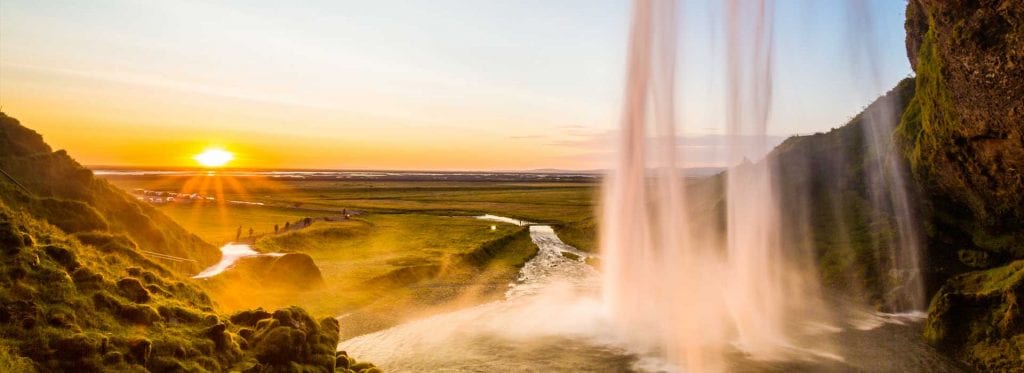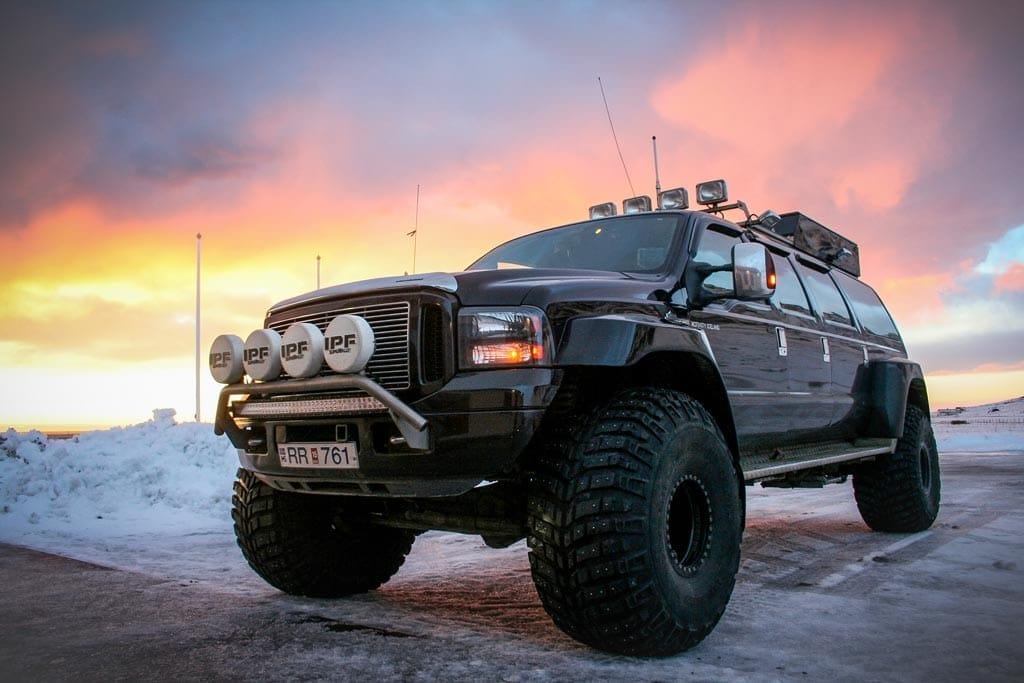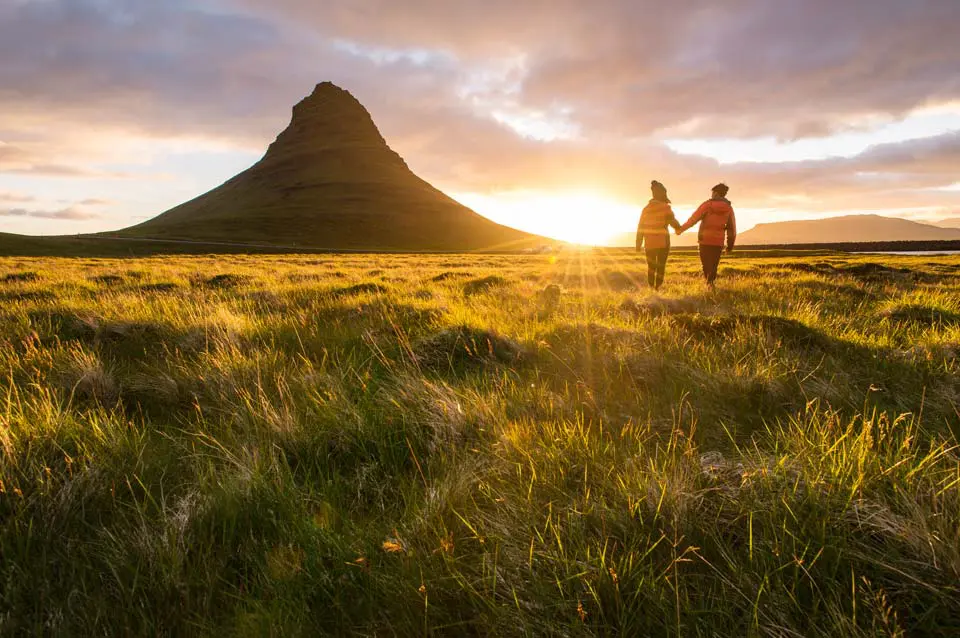Summer in Iceland starts in June and ends in August. The average summer temperature is 10°C (50 F), and the warmest it gets is 20°C (68 F). It gets a little chilly and windy even in summer (especially outside Reykjavik), and you may want to bring a hat and gloves. Although summer has the least amount of rainfall in Iceland, rain is not uncommon every now and then.
Why visit Iceland during the summer?
24 Hour Daylight
The sun does not completely set during the summer months, given the country’s location near the Arctic. In June, you get near-endless bright skies and the famous midnight sun, where the sun does not set for 24 hours (solar solstice). At the summer solstice on 21st June, part of the north experiences 24 hours of sunshine while the capital, Reykjavik, only receives 3 hours of darkness. You will get to see the amazing pinky-peach glow on late-evening skies even when the sun finally sets.
Other than the prolonged time to engage in outdoor activities, there are many midnight sun events to look forward to. These include music festivals, midnight sun runs, golf tournaments, and more.

Outdoor Activities
Although temperatures in Iceland are unlikely to reach tropical or subtropical temperatures, it can get quite sunny and pleasant in the summer months. On a warm summer day, temperatures of 20-25 °C (68-77 °F) are not uncommon. Even on an average day with temperatures close to 10-15 °c (50-59 °F), there are many outdoor activities to participate in. These include:
A Drive along the Golden Circle Route
The 190-mile Golden Circle route includes the most popular places and attractions in Iceland. These include the Þingvellir National Park, where you can hike and learn about the first parliament in the world, the Geysir Geothermal Area, where you can see the exploding geysers and Strokkur, which spouts water 100 feet into the air periodically, and Gullfoss Waterfall which is the most beautiful waterfall in Iceland.
A Dip in the Blue Lagoon
No visit to Iceland is complete without a visit to the famous Blue Lagoon. This is indeed one of the wonders of the world. Its waters and mud contain minerals that are therapeutic to the skin. The Blue Lagoon’s waters are sustained by geothermal activity and are replenished naturally every 48 hours.
Puffin Watching
Westman Islands has the biggest Atlantic puffin colony worldwide. About 20% of the world’s population of puffins arrives to nest here from late April to the end of August. The rest of the year, they are out at sea. Puffins are cheeky-looking birds that have orange webbed feet and colorful beaks. They are very photogenic and fascinating to watch. As soon as you see the puffins, you will understand why people travel from afar to see them in their natural habitat.
Whale Watching
During the summer, 23 whale species migrate to the shallower waters of Iceland’s fjords to feed on krill and fish. This gives you a great opportunity to view the majestic creatures in the wild. The most common species in the waters are Minke and humpback whales. You may also catch a glimpse of white-beaked dolphins, seals, and basking sharks.

Exploring the South Coast
The South Coast of Iceland has many attractions to explore during the summer. The Skógafoss waterfall is simply stunning. You can walk along the Black Sand Beach, visit the Seljalandsfoss waterfall, and visit the Sólheimajökull Glacier. It will take you 8 to 10 hours to drive through these sightseeing spots, explore some of them, and then drive back to Reykjavik.
Catching a Local Festival
Almost all villages in Iceland have festivals in summer. A local festival allows you to engage intimately with the locals and see a different way of living. Some of the best festivals are the Swamp Soccer tournament at Isafjordur, the Viking Festival on Hafnarfjörður, Seafarer’ Day, Culture Night and Marathon in Reykjavík, the Lobsterfest at Hofn, the LungA Art Fest at Seydisfjordur, the Fishfest at Dalvik, and Ein með ollu at Akureyri.
An Excursion to the Highlands
The highlands are impassible in the winter months, so summertime is the best time to discover this remote yet stunning region. You get to see vast glaciers, towering volcanoes, mountains, and a lot more. The roads are usually open between mid-June and late September, depending on the snow and weather. Only 4×4 vehicles are able to go on these mountain roads since they are rough and unpaved, and you will be crossing un-bridged rivers.

A Visit to the Westfjords
The remote Westfjords peninsula is one of the most sparsely populated regions in Iceland, alongside the highlands. It is characterized by unspoiled natural landscapes like mountains and fjords. It has a beautiful coastline where you can walk on the red sand beaches and along the hiking paths. You can learn about the history of the area in Ísafjörður, which is the largest settlement in the Westfjords.
At Deluxe Iceland, we have several summer packages for you to pick from. The Iceland Summer Highlights, available from May to September, is a self-drive package for 8 days/7 nights. This tour takes you to the South Shore of Iceland and the most popular attractions on the route. It also includes a stunning drive through all the fjords and sailing among the icebergs in the Glacier Lagoon. Icelandic Summer Adventures is a privately guided tour that takes 8 days/7 nights. You get to know more about the capital, drive through lava fields on ATVs, sail among the icebergs, and soak in geothermal water. Yet another summer package is the Summer Getaway, which is a 7-day/6-night privately guided tour. You will engage in such activities as horseback riding and sailing.
We can tailor all our tours to your exact needs and interests. We are a fully authorized luxury travel agency and tour operator. Our local team of guides has vast experience to ensure you get the best out of your visit and guaranteed safety. If you have any questions, feel free to contact us today and we will reply quickly.
